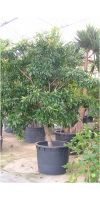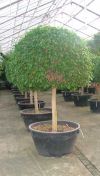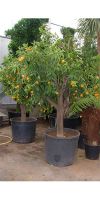Products description
Podocarpus macrophyllus (Kusamaki or Inumaki) is a conifer in the genus Podocarpus, family Podocarpaceae. It is the northernmost species of the genus, native to southern Japan and southern China. Kusamaki and Inumaki are Japanese names for this tree, and Kusamaki is increasingly being used as the English name as well, replacing the old, botanically inaccurate names "buddhist pine" and "fern pine" (it is not a pine).
In China, it is known as 羅漢松 luo han song. It is a small to medium size evergreen tree, reaching 20 m tall. The leaves are strap-shaped, 6-12 cm long, and about 1 cm broad, with a central midrib. The cones are borne on a short stem, and have 2-4 scales, usually only one (sometimes two) fertile, each fertile scale bearing a single apical seed 10-15 mm. When mature, the scales swell up and become reddish purple, fleshy and berry-like, 10-20 mm long; they are then eaten by birds, which disperse the seeds in their droppings.
Kusamaki is the state tree of Chiba Prefecture, Japan. It is a popular large shrub or small tree in gardens, particularly in Japan and the southeastern United States. The ripe cone arils are edible, though the seed should not be eaten. Buddhist Pine (Podocarpus macrophyllus) in Hong Kong is regarded as a Fung Shui tree, thus having a very high market value. In recent years, the illegal digging of Buddhist Pine has become a problem in the city.
A popular plant for indoor Bonsai culture. Podocarpus marki grows very slowly and is very easy to care for.
Light: half shade / sun
Temperature: from 6°C to 28°C
Humidity: dry to moist
Cultivation areas: large lobbies, restaurants and hotel facilities with high glassed rooms, offices, open-plan offices
Height: 275 cm
Container: 80 cm






